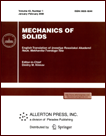 | | Mechanics of Solids
A Journal of Russian Academy of Sciences | | Founded
in January 1966
Issued 6 times a year
Print ISSN 0025-6544
Online ISSN 1934-7936 |
Archive of Issues
| Total articles in the database: | | 13362 |
| In Russian (Èçâ. ÐÀÍ. ÌÒÒ): | | 8178
|
| In English (Mech. Solids): | | 5184 |
|
| << Previous article | Volume 59, Issue 7 / 2024 | Next article >> |
| D.S. Dudin and I.E. Keller, "On the Decomposition of Motion in the Description of Interdiffusion in a Viscoelastic Body," Mech. Solids. 59 (7), 3781-3797 (2024) |
| Year |
2024 |
Volume |
59 |
Number |
7 |
Pages |
3781-3797 |
| DOI |
10.1134/S0025654424606013 |
| Title |
On the Decomposition of Motion in the Description of Interdiffusion in a Viscoelastic Body |
| Author(s) |
D.S. Dudin (Institute of Continuous Media Mechanics of the Ural Branch of Russian Academy of Science, Perm, 614013 Russia, dudin.d@icmm.ru)
I.E. Keller (Institute of Continuous Media Mechanics of the Ural Branch of Russian Academy of Science, Perm, 614013 Russia, kie@icmm.ru) |
| Abstract |
The influence of stresses on diffusion is recognized, along with diffusion’s role in the viscous deformation of solids. The interconnection between interdiffusion and deformations in metallic
alloys and steels significantly affects the durability of machine components exposed to harsh conditions with substantial temperature and force. In such instances, diffusion facilitates the transportation
of alloying elements from the surface layer, impacting the intensity of corrosion and corrosion cracking. Laws correlating diffusion flows to chemical potential gradients can be related to various diffusion
reference frames, determined by the base experiment used or the convenience of establishing the
boundary value problem. In the related equations of interdiffusion in a deformable solid, we must consider that diffusion happens in a local material volume transported by the convective velocity, and that
diffusion is described in a local diffusion frame of reference moving relative to the material. A decision
must be made regarding convective velocity and diffusion reference frame (decomposing the material
motion into convective and diffusive parts). Within the linear thermodynamics of irreversible processes, a related system of equations is set for a multicomponent medium, where balance equations for
composition variables are considered, and stress and strain tensors are introduced for the medium on
the whole. Two diffusion descriptions are considered: one assumes a diffusion reference frame frozen
into a local material volume, and the other involves a system of markers, small inert particles, moving
relative to the material due to unbalanced diffusion flows. Both methods are employed in basic diffusion pair experiments to determine diffusion coefficients. For each of the diffusion descriptions –“material” and “marker” – within the process coupled with viscoelastic deformation, the thermodynamically resolved relations are derived for two-component and three-component metallic alloys.
To compare the associated models, a one-dimensional problem is proposed. The perturbation method
is applied, yielding the dependency of the relaxation time spectrum on the perturbation wavelength.
The values of the effective interdiffusion coefficients align with the inclined asymptotes of these
dependencies, and the effective viscosity coefficients match the horizontal ones. The dependency of
these effective coefficients on the diffusion and viscoelastic properties for an austenitic alloy Fe65-Cr20-Ni15 at high temperature is examined. Overall, the marker description of interdiffusion provides
more information and it is more convenient for setting boundary value problems with boundary diffusion of components. |
| Keywords |
interdiffusion, elastoviscosity, coupled processes, diffusion reference frames, decomposition of motion, perturbation relaxing |
| Received |
19 October 2024 | Revised |
28 October 2024 | Accepted |
29 October 2024 |
| Link to Fulltext |
|
| << Previous article | Volume 59, Issue 7 / 2024 | Next article >> |
|
 If you find a misprint on a webpage, please help us correct it promptly - just highlight and press Ctrl+Enter If you find a misprint on a webpage, please help us correct it promptly - just highlight and press Ctrl+Enter
|
|

 Russian
Russian  English
English